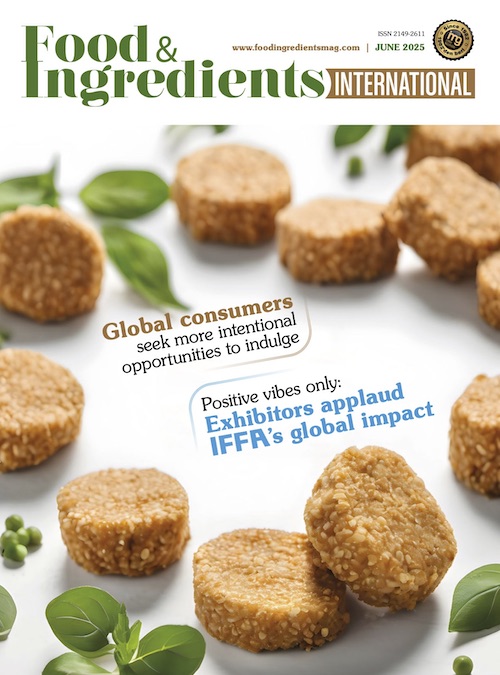Plant-based Diet and Impacts
In recent years, a dramatic increase has been seen in the spread of chronic diseases worldwide. Annually, at a global level, 63% of the total mortality rate reason is obesity, cardiovascular disease, diabetes, and malignant tumor. Moreover, the rate of chronic diseases is almost 45,9% of all diseases worldwide. (Fehér, Gazdecki, Véha, Szakály, & Szakály, 2020). In consideration of all these data, people start to adopt healthier diets in their daily life. Healthier diet trends have been correlated with consuming lower amounts of animal products by individuals. As a result of that, different eating patterns have arisen and gained popularity day by day and induce various diets and applications. The most common ones can be exemplified as:
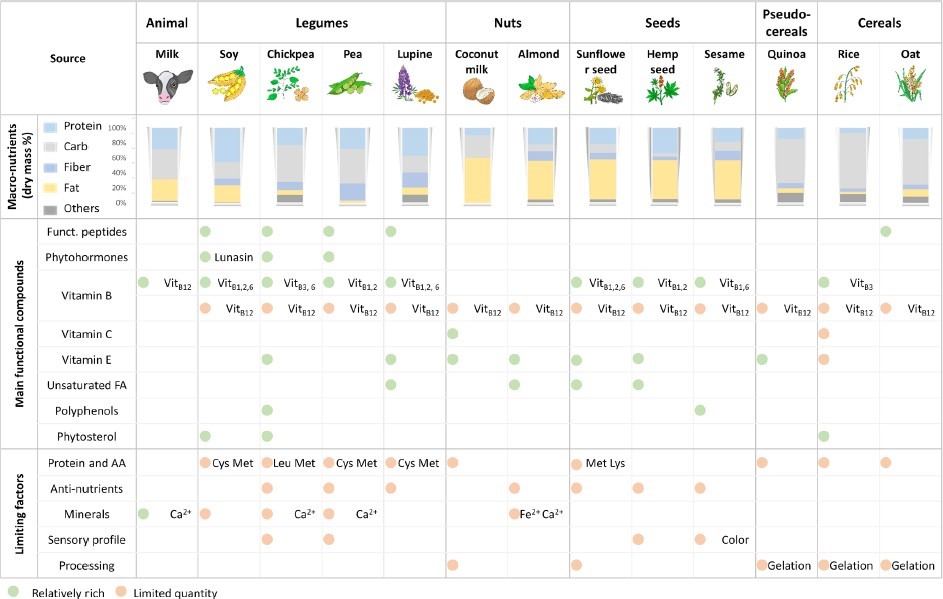
- Vegan diet:
Omitting all animal products, including dairy, meat, fish, eggs, and (usually) honey (World Health Organization, 2021)
- Vegetarian diet:
Excluding meat and fish but may consume egg and milk-based products (Noguerol, Pag´an, García-Segovia, & Varela, 2021)
- Semi-vegetarian (flexitarian) diet:
Following a primarily but not strictly vegetarian diet, occasionally eating meat, fish, or dairy in small quantities (Derbyshire, 2017)

Limiting consumption of meat and meat-derived products leads lower risk of obesity, type 2 diabetes, and certain cancers such as colorectal cancer. Moreover, there is an environmental impact like reducing greenhouse gas emissions. While the consumption of animal products has decreased, there is an observable increase in the intake of plant-based products. The plantbased term is described as preferring plantbased alternatives instead of animal-based products. These plant-based alternatives are exemplified as vegetables, beans and legumes, fruits, whole grains, nuts, and seeds (Noguerol, Pag´an, García-Segovia, & Varela, 2021).
Despite lots of benefits of plant-based diets, awareness of lacking some specific micronutrients is crucial, especially for vegan diets. Those micronutrients such as vitamin A, B2, B12, D zinc, calcium, and selenium have lower availability in plant-based food compared with animal sources (see Figure 1). Low intakes of these micronutrients may negatively affect several body functions including the nervous system. People who consume a vegan diet should also be aware daily need for vitamin intake and consume fortified foods to balance it (Noguerol, Pag´an, García-Segovia, & Varela, 2021).
Plant-based dairy substitutes and consumer attitudes
The plant-based category has a variety of products that are developed as substitutes for those produced from animals such as milk, meat, eggs, fish, and products where they are utilized. Milk and thereof product analogs are reviewed and detailed in this paper. Plant-based products are expected to have specific physical, chemical, functional, nutritional, and sensory characteristics. The plant-based products are developed by using suitable mixtures of ingredients and production technologies to resemble the structures of animal products. Therefore, plant-based ingredients’ physicochemical and structural properties knowledge is needed in this regard (McClements & Grossmann, A brief review of the science behind the design of healthy and sustainable plant-based foods, 2021).
A variety of plant-derived ingredients are used in this sector while plant-based products are designed. It is crucial that the selection of plantderived ingredients and their functionalities. Knowing the ingredients and final product requirements is needed to understand the science behind plant-based products. The ingredients change up to the type of final product. Basically, the main ingredients are listed in the following.
Proteins are crucial ingredients used in varied plant-based products since they provide emulsifying, structuring, texturizing, foaming, and nutritional properties. Therefore, proteins are key ingredients in order to obtain a high-quality final product. They can be concentrated or isolated from botanical sources such as soy, pea, lentil, chickpea, lupin, canola, and corn zein. They are used as a protein source in plant-based foods (McClements & Grossmann, The science of plantbased foods: Constructing next-generation meat, fish, milk, and egg analogs, 2021).
Carbohydrates which are in the forms of monosaccharides or disaccharides are used to enable the final plant-based products to be sweet. Starch, methylcellulose, pectin, guar gum, xanthan gum, and other types of polysaccharides are also used as a thickening, emulsifying, and gelling agents (McClements & Grossmann, The science of plant-based foods: Constructing next-generation meat, fish, milk, and egg analogs, 2021).
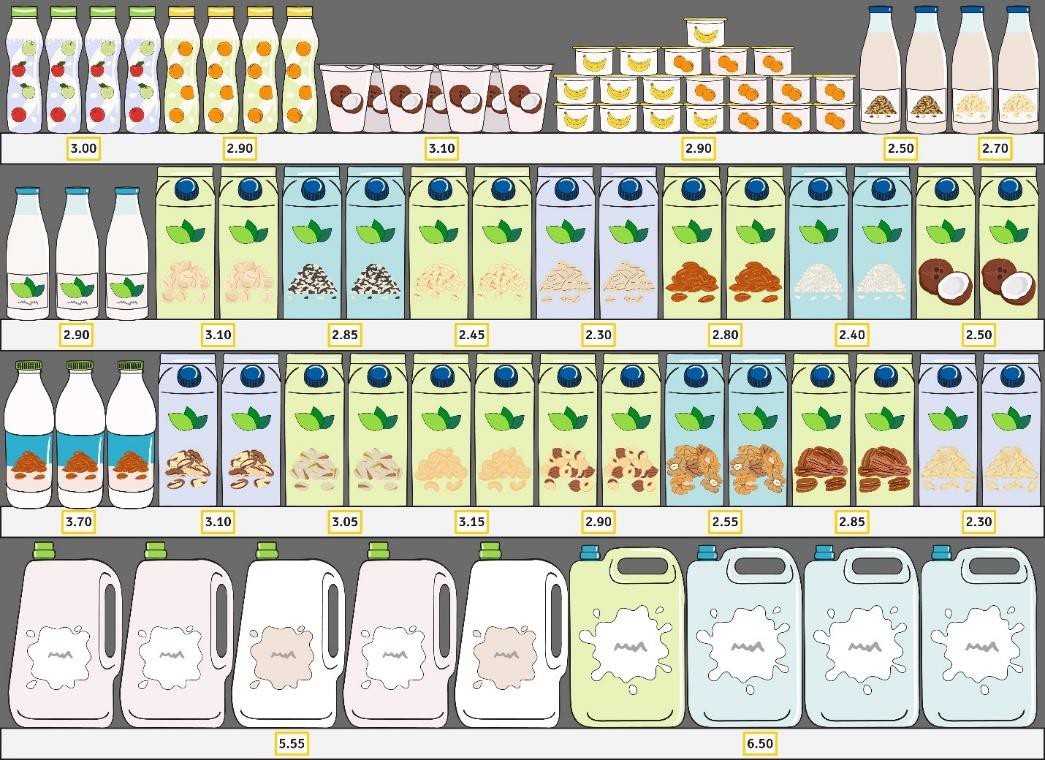 Lipids are also another key ingredient in plantbased products. Fats and oils which can be extracted from coconut, cocoa, corn, flaxseed, and so on, can provide the desired texture properties. Thanks to simulating the crystallization characteristic of lipids, they have the property to mimic animal fat thus they can be chosen to be added to the recipes of plant-based products (McClements & Grossmann, 2021).
Lipids are also another key ingredient in plantbased products. Fats and oils which can be extracted from coconut, cocoa, corn, flaxseed, and so on, can provide the desired texture properties. Thanks to simulating the crystallization characteristic of lipids, they have the property to mimic animal fat thus they can be chosen to be added to the recipes of plant-based products (McClements & Grossmann, 2021).
Flavors, colorants, buffering agents, preservatives, and crosslinking agents are also required in the recipe so that forming better plant-based foods.
Plant-based dairy alternatives can be categorized into bases. They can be based on cereals (rice, oat), legumes (soy and pea), vegetables, seeds (flax, hemp), and nuts (almond, coconut, nut, cashew). Dairy analogs of plantbased, which are formed by water extracts from plants, are listed as milk, yogurt, cheese, cream, butter, and ice cream. (Adamczyk, Jaworska, Affeltowicz, & Maison, 2022).
Plant-based milk category is present for a while. It is not a new category in this sector. It was in the niche market in the beginning, but it gains popularity (Haas, Schnepps, Pichler, & Meixner, 2019). There is an increasing trend in terms of milk alternatives in developed countries because of milk allergy, lactose intolerance, and altering life and food styles. Plant-based milk substitutes are known as water extracts of dissolved and disintegrated plants. Soy milk, which is first commercially produced in the 1940s, is commonly chosen in the plant-based dairy alternative category (Jeske, Zannini, & Arendt, 2018). On the other hand, oat milk has gained the popularity in last 3 years. Research in the UK (see Figure 2) demonstrates that oat milk has risen trend when it is compared with other plant-based substitutes. Social media and younger generations drove the oat milk growth in milk substitutes (Buchet, 2022).
Milk as a by-product of coffee is a crucial strategical factor. According to research in Australia, consumer groups expect plant milk for being more suitable for coffee. Thus, plant-based barista milk alternatives are now commonly spread in order to meet consumers’ demands (Haas, Schnepps, Pichler, & Meixner, 2019).
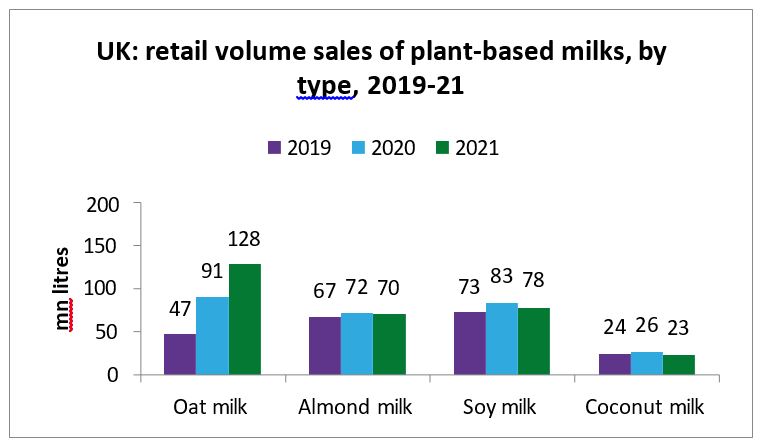
Cheese substitutes are oil-in-water emulsion which is similar to traditional cheeses. Proteins have the role of emulsifiers and give the desired structures. In contrast to dairy-based cheese, plant-based cheeses do not contain casein and its interactions with other components. The nature of plant-based protein is different from milk proteins. The structure of dairy cheese is mimicked by enzymatic coagulation. However, it is hard to produce hard cheeses with this. The structure should be supported with thickening agents (Jeske, Zannini, & Arendt, 2018).
The young generation has a less tendency to consume dairy cheeses when compared with Generation X (see Figure 3). As shown in research in the following graph, generation Z and millennials prefer plant- based cheeses. Therefore, it is suggested that the producers should focus on the young generation to increase the market share in this category. Besides, the young consumers will be a crucial segment for the conventional and plant-based cheese categories to compete in since they identify as flexitarians and aim to restrict their use of animal-based products (Roberts, 2022). Plant-based milk substitutes can be formulated like milk. They are also used in the cream alternatives, ice cream and chocolate formulations. For instance, tiger nut is used in the plant-based ice cream since it provides the desired physicochemical properties, viscosity, overrun, meltdown, and sensory properties (Jeske, Zannini, & Arendt, 2018).
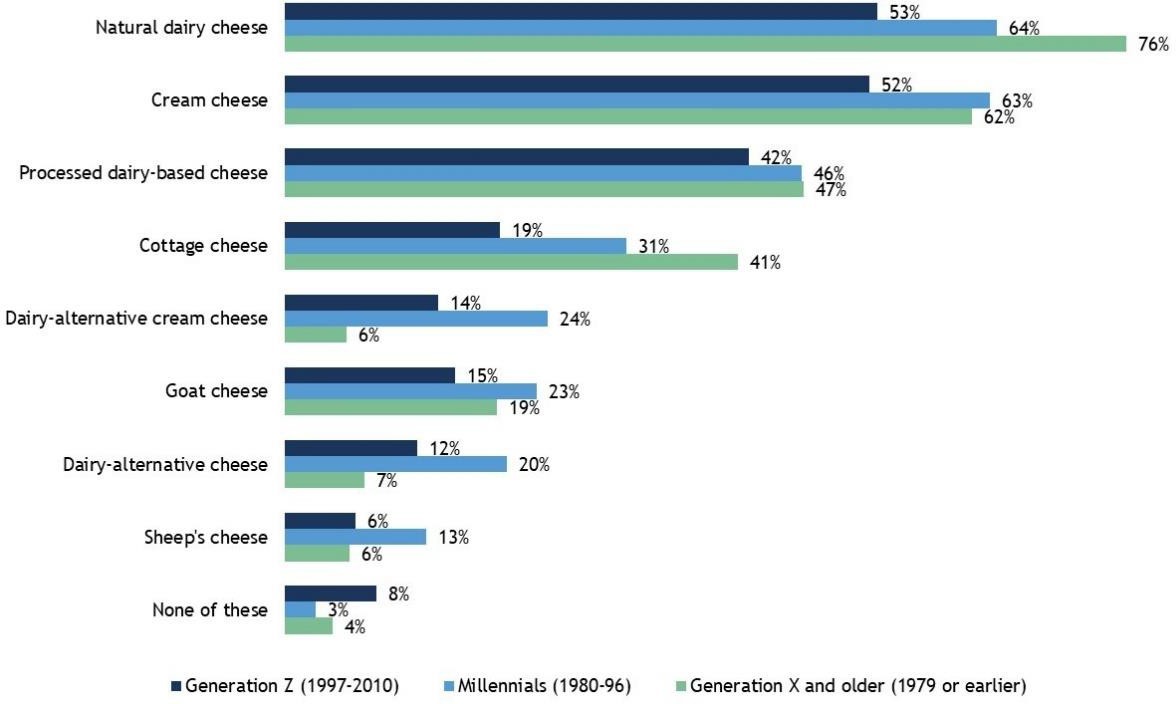
The plant-based category is not limited to these. The consumers’ attention to the category is increasing day by day. Thus, the number and variety of dairy substitute products have also risen.
Fermented plant-based products-non dairy alternatives
In recent years, plant-based milk alternatives have gained popularity in the food market. Although, increasing market share, the common output is plant-based milk alternatives have undesirable off flavors compared with regular animal milk. Besides, unbalanced nutrition may still negatively effects the consumption by individuals. In order to prevent off-flavor and unbalanced nutrition values, fermentation is a traditional and effective solution since the early days of mankind. (Adler, Bolten, Dohnt, Hansen, & Wittman, 2013) In former times, plant-based sources especially maize, wheat, and sorghum have been used in the fermentation process. The sugar and protein content of those cereals provide the growth of the microorganism. The most commonly used microorganisms are Lactic acid bacteria (LAB), bacilli, and yeasts.
Fermentation improves the quality of the final product by stabilizing of the food system, contributing the sensory profile and texture, preventing spoilage. The positive effects of the fermentation may be observed in the production of wine, cheese, yoghurt, chocolate, bread, pickles etc.
Sensory profile aspect: Taste plays a crucial role in preferring a product in the market. Unfortunately, plant-based milk alternatives have a displeasing impact when compared with regular cow milk due to off taste. For instance, legume-based milks smell earthy and beany. The main reason of this kind of off flavors are volatile compounds like n-hexenal and n-hexanol which occur from lipid oxidation. Also, plant phenols, glucosinolates, terpenes, and flavonoids taste bitter and acid or astringent. On the contrary, soluble fibers have an impact positively in terms of mouthfeel and texture. (Tangyu, Muller, Bolten, & Wittmann, 2019)
Fermentation improves the off flavors and generates desirable volatile compounds. For instance, while cereal-based product is fermenting, diacetyl (2,3-butanedione) arises and smells a butterscotch-like aroma. Besides, plant-based milk’s flavors are affected by changes in the level of amino acids. In addition, fermented peanut milk has a significant difference from regular peanut milk in terms of whiteness, smoothness, and viscosity and decreased beany flavors by fermenting with L. delbrueckii subsp. bulgaricus and Streptococcus thermophilus. Also, after the fermentation of almonds, more bright and white products have been seen by fermenting with Lactobacillus reuteri and S. thermophilus. (Tangyu, Muller, Bolten, & Wittmann, 2019)
Nutrition aspect:
Plant-based milk alternatives contain various valuable micronutrients. To illustrate, almond, peanut, coconut are good sources of vitamin C and E which is an antioxidant. Legumes are enriched by essential mono and polyunsaturated fatty acids and minerals like Fe2+ Zn2+, Mg2+ (Sandberg, 2002).
However, most of them are not generally nutritionally balanced. Therefore, commercial products have been fortified with some supplements like vitamins, minerals, sweeteners, and amino acids. These additives should be labeled in the ingredient list, and it seems crowded and not cleanly labeled for final product. Consumers perceive these products as artificial and do not prefer to purchase them. Thus, cleanly labeled products have become an expectation for consumers. At that point, fermenting plantbased milk alternatives may help to improve nutritional value more safely and naturally.
For instance, fermenting soybean with Lactobacillus plantarum increases the essential amino acids like L- lysine. Besides, during fermentation, specific microbial strains lead to the synthesis of vitamin K and vitamin B groups. Yeasts have also a positive impact in terms of nutrition. They are able to produce vitamin B2. (Tangyu, Muller, Bolten, & Wittmann, 2019) (Figure 4)
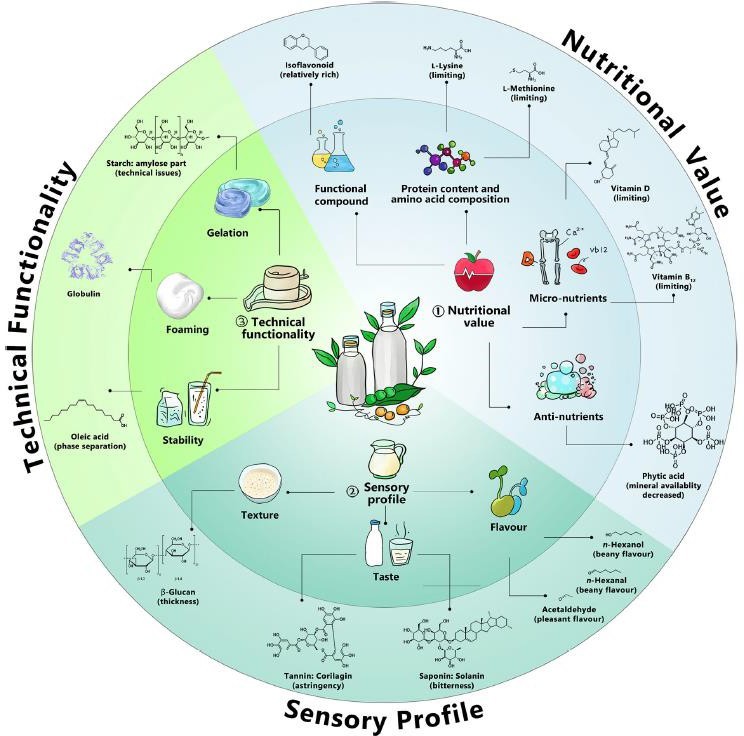
Plant-based trend and sustainability relation
Plant-based dairy substitute market is expected to expand rapidly and gain popularity on a global scale. Plants like lupine or tiger nuts have lately emerged in or from these markets. There can arise new types of plants in this category in the time since consumers seek a variety. The non-dairy market may also be affected by trends seen in the dairy industry. The principal sources of protein should switch from resource-intensive foods like meat and dairy products to plantbased proteins, even though it is predicted that protein consumption would increase by 80% by 2050 (Jeske, Zannini, & Arendt, 2018).
There is no denying the popularity of plant-based diets. If this sector keeps growing, the worldwide market, which was worth $29 billion in 2020, might reach $160 billion by 2030. The category is strongly dependent on claims of sustainability and the positioning of that claim (Shor, 2022). The findings demonstrate that the production of milk analogs uses far less land, water, emits fewer greenhouse gases, and causes less pollution than the production of actual milk.
For instance, soymilk consumed 93% less land, 96% less water, 69% less greenhouse gas, and 90% less eutrophication when it is compared with normal milk (see Figure 5). Additionally, according to the FAO of the United Nations, there are around 264 million dairy cows utilized to produce milk and dairy products globally. There are concerns regarding the conditions of cows and animal wellbeing. These results show that increasing the use of plant-based milk alternatives would have significant positive effects on the environment and ethical behavior (McClements & Grossmann, The science of plant-based foods: Constructing next-generation meat, fish, milk, and egg analogs, 2021).
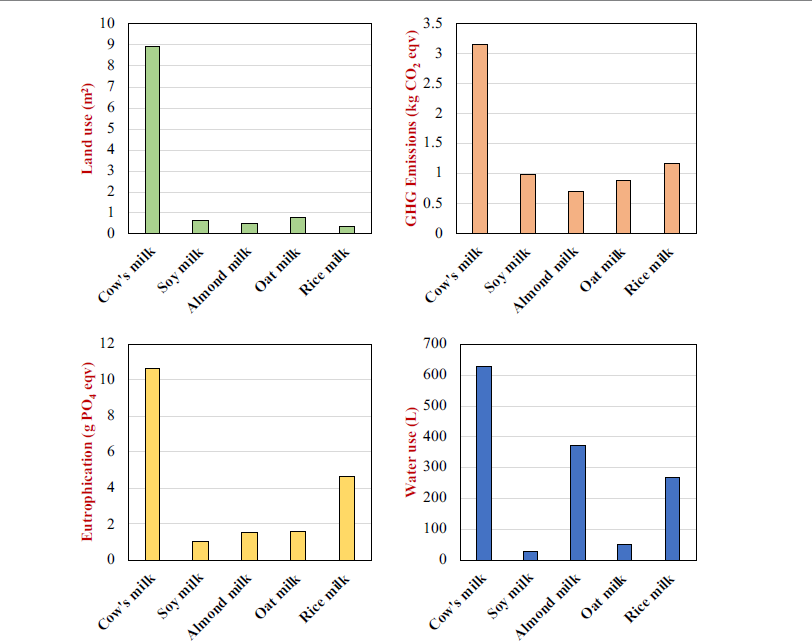
For the flexitarian market, there is rising interest in creating hybrid products that combine ingredients from both plants and animals. These hybrid products intend to improve sustainability and the environment by reducing the overall percentage of foods produced from animals consumed. Hybrid products’ sensory qualities and nutritional value may also be improved, raising their acceptability among consumers by just substituting a few of the animal components with plant-based ones. As the majority of customers are neither vegans nor vegetarians, these sorts of products might significantly improve the sustainability of the current food supply (McClements & Grossmann, The science of plant-based foods: Constructing next-generation meat, fish, milk, and egg analogs, 2021).
References:
Adamczyk, D., Jaworska, D., Affeltowicz, D., & Maison, D. (2022). Plant-Based Dairy Alternatives: Consumers’ Perceptions,Motivations, and Barriers—Results from Qualitative Study in. Nutrients, 14-28.
Adler, P., Bolten, C. J., Dohnt, K., Hansen, C. E., & Wittman, C. (2013). Core fluxome and metafluxome of lactic acid bacteria under simulated cocoa pulp fermentation conditions. Appl Environ Microbiol.
Buchet, O. (2022, November 16). Use oat milk’s appeal to innovate in ice cream. Retrieved from Mintel: https://clients.mintel.com/content/ insight/use-oat-milk-s-appeal-to-innovate-inice- cream?fromSearch=%3Ffreetext%3Dpla nt-%2520based%2520dariy%26sortBy%3Drecen t%26resultPosition%3D1
Derbyshire, E. J. (2017). Flexitarian Diets and Health: A Review of the evidence-Based Literature. Frontiers in Nutrition.
Fehér, A., Gazdecki, M., Véha, M., Szakály, M., & Szakály, Z. (2020). A Comprehensive Review of the Benefits of and the Barriers to the Switch to a Plant-Based Diet. Sustainability.
Haas, R., Schnepps, A., Pichler, A., & Meixner, O. (2019). Cow Milk versus Plant-Based Milk Substitutes:A Comparison of Product Image and Motivational Structure of Consumption. Sustainability, 11.
Jeske, S., Zannini, E., & Arendt, E. K. (2018). Past, present and future: The strength of plant-based dairy substitutes based on gluten-free raw materials. Food Research International, 42-51. McClements, D. J., & Grossmann, L. (2021). A brief review of the science behind the design of healthy and sustainable plant-based foods. npj Science of Food, 5-17.
McClements, D. J., & Grossmann, L. (2021). The science of plant-based foods: Constructing next- generation meat, fish, milk, and egg analogs. Institute of Food Technologists, 1-52.
McClements, D. J., Newman, E., & McClements, I. F. (2019). Plant-based Milks: A Review of the Science Underpinning Their Design, Fabrication, and Performance. Institute of Food Technologists, 1-21.
Noguerol, A. T., Pag´an, M., García-Segovia, P., & Varela, P. (2021). Green or clean? Perception of clean label plant-based products by omnivorous, vegan, vegetarian and flexitarian consumers. Food Research International.
Roberts, W. (2022). Cheese-US-2022. Retrieved from Mintel: https://reports.mintel.com/ display/1099929/?highlight
Sandberg, A.-S. (2002). Bioavailability of minerals in legumes. Br J Nutr. Shor, D. (2022, November 2). The Future of Plantbased Food and Drink. Retrieved from Mintel: https://clients.mintel.com/content/trend/thefuture-of-plant-based-food-and- drink?fromSe arch=%253Ffreetext%253Dplant-based%25252 0dairy%2526resultPosition%253D1
Tangyu, M., Muller, J., Bolten, C. J., & Wittmann, C. (2019). Fermentation of plant-based milk alternatives for improved flavour an nutritional value. Applied Microbiology and Biotechnology.
World Health Organization. (2021). Plant-based diets and their impact on health, sustainability and the environment: a review of the evidence. Copenhagen: World Health Organization.















